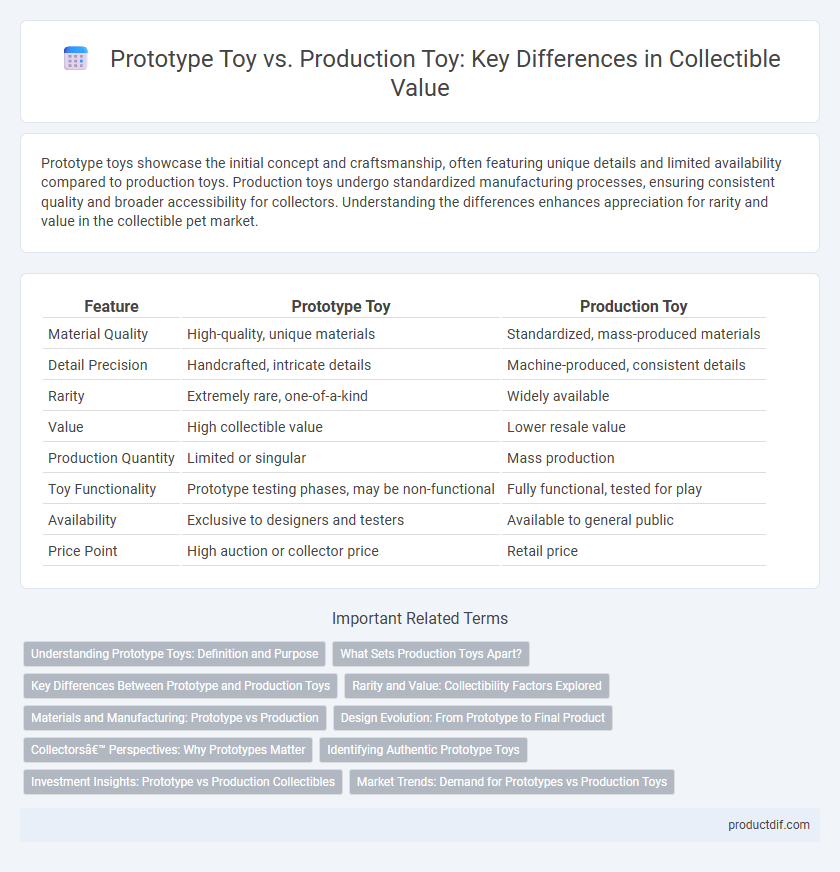Prototype toys showcase the initial concept and craftsmanship, often featuring unique details and limited availability compared to production toys. Production toys undergo standardized manufacturing processes, ensuring consistent quality and broader accessibility for collectors. Understanding the differences enhances appreciation for rarity and value in the collectible pet market.
Table of Comparison
| Feature | Prototype Toy | Production Toy |
|---|---|---|
| Material Quality | High-quality, unique materials | Standardized, mass-produced materials |
| Detail Precision | Handcrafted, intricate details | Machine-produced, consistent details |
| Rarity | Extremely rare, one-of-a-kind | Widely available |
| Value | High collectible value | Lower resale value |
| Production Quantity | Limited or singular | Mass production |
| Toy Functionality | Prototype testing phases, may be non-functional | Fully functional, tested for play |
| Availability | Exclusive to designers and testers | Available to general public |
| Price Point | High auction or collector price | Retail price |
Understanding Prototype Toys: Definition and Purpose
Prototype toys are initial models created to test design, functionality, and market appeal before mass production. These unique items often feature variations and imperfections absent in production toys, making them highly valuable to collectors. Understanding the purpose of prototype toys highlights their role in product development and their rarity within the collectible market.
What Sets Production Toys Apart?
Production toys are distinguished by their standardized quality, consistent detailing, and mass availability, making them more accessible to collectors. Unlike prototype toys, which often feature unique or experimental designs and limited finishes, production toys undergo rigorous quality control for uniformity in appearance and durability. Their widespread distribution and official branding further enhance their value and verification in the collectible market.
Key Differences Between Prototype and Production Toys
Prototype toys often feature unique design elements and limited detailing that differ significantly from mass-produced production toys, making them rare collectibles. Production toys are typically standardized for durability and cost-efficiency, resulting in consistent quality and finishes across all units. Collectors value prototypes for their originality and exclusivity, while production toys are prized for their accessibility and complete sets.
Rarity and Value: Collectibility Factors Explored
Prototype toys are exceedingly rare, often produced in very limited quantities for testing or marketing purposes, which significantly enhances their value among collectors. Production toys, while more widely available, gain value through limited editions, condition, and demand but generally lack the unique appeal of prototypes. The rarity of prototype toys directly correlates with higher market prices, making them highly sought-after in the collectible toy community.
Materials and Manufacturing: Prototype vs Production
Prototype toys often feature unique materials such as resin or clay, allowing for intricate detailing and rapid adjustments during the design phase. Production toys prioritize durability and cost efficiency, commonly utilizing injection-molded plastics and standardized components to ensure uniformity across large batches. Differences in manufacturing methods cause prototype toys to possess finer surface textures, while production toys emphasize consistency and scalability in material application.
Design Evolution: From Prototype to Final Product
Prototype toys showcase initial design concepts with rough detailing and experimental materials, capturing the creator's raw vision. Production toys undergo refined sculpting, color adjustments, and quality control to meet market standards and consumer expectations. These design evolutions from prototype to final product highlight improvements in durability, aesthetics, and playability, essential for collectible value and authenticity verification.
Collectors’ Perspectives: Why Prototypes Matter
Collectors value prototype toys for their rarity and unique design features that often differ from final production versions, making them prized artifacts in toy history. These prototypes provide insight into the creative process and manufacturing decisions, offering a tangible connection to a toy's developmental journey. Owning a prototype elevates a collection's prestige, showcasing exclusivity and a deeper appreciation for the evolution of beloved characters or themes.
Identifying Authentic Prototype Toys
Authentic prototype toys can be identified by unique manufacturing marks, unfinished paint jobs, and limited production runs, distinguishing them from mass-produced production toys. Collectors should examine early design variations and consult manufacturer archives or trusted authentication services to verify originality. These characteristics significantly impact the toy's rarity and value within the collectible market.
Investment Insights: Prototype vs Production Collectibles
Prototype toys often exhibit unique design elements and limited availability, making them highly sought after by collectors and potentially more valuable over time. Production toys, while more common and widely distributed, provide safer investment opportunities due to established demand and recognized market values. Understanding rarity, condition, and provenance plays a crucial role in assessing the investment potential of prototype versus production collectibles.
Market Trends: Demand for Prototypes vs Production Toys
Prototype toys often command higher prices in the collectible market due to their rarity and unique features not found in production toys, attracting serious collectors and investors. Production toys dominate in volume sales, benefiting from wider distribution and brand recognition, but their value typically remains lower compared to prototypes. Market trends show growing interest in prototypes driven by nostalgia and exclusivity, while production toys retain steady demand as accessible collectibles for casual buyers.
Prototype Toy vs Production Toy Infographic

 productdif.com
productdif.com